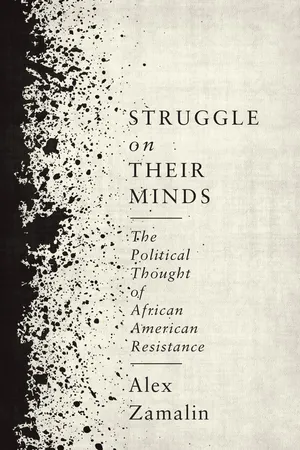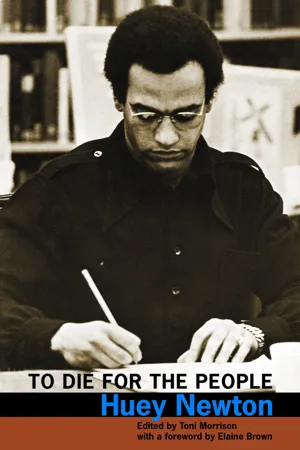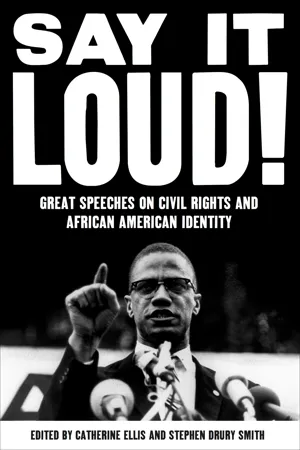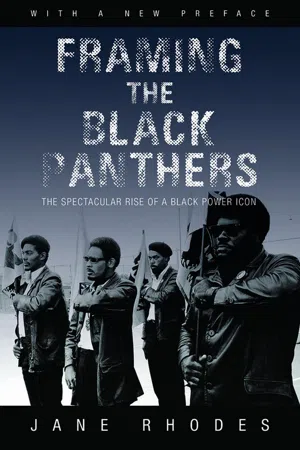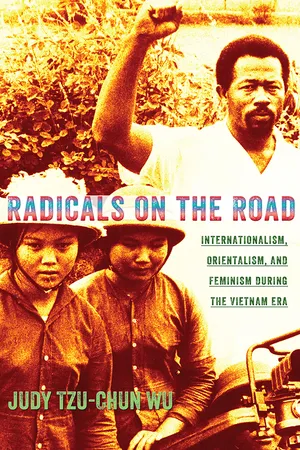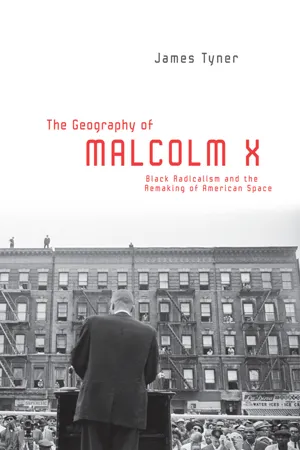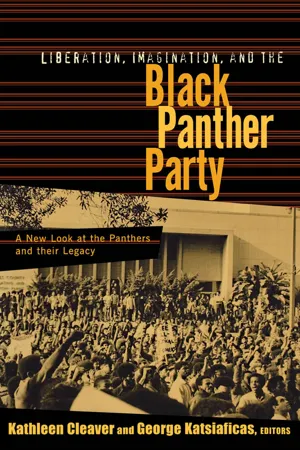Politics & International Relations
Huey Newton
Huey Newton was a prominent figure in the Black Power movement and co-founded the Black Panther Party in 1966. He advocated for self-defense and empowerment of the African American community, and his party's activities included community programs and monitoring police behavior. Newton's ideas and activism had a significant impact on the civil rights movement and the struggle for racial equality in the United States.
Written by Perlego with AI-assistance
Related key terms
7 Key excerpts on "Huey Newton"
- eBook - ePub
Struggle on Their Minds
The Political Thought of African American Resistance
- Alex Zamalin(Author)
- 2017(Publication Date)
- Columbia University Press(Publisher)
3 Huey Newton, THE BLACK PANTHERS, AND THE DECOLONIZATION OF AMERICAA n iconic photograph taken in 1967 captured everything Americans thought they knew about Huey P. Newton, the minister of defense and founding member of the Black Panther Party for Self-Defense, which was created in 1966. Seated in a peacock wicker chair, adorned in a leather jacket, white collared shirt, jeans, and his signature beret, tilted to the right, while holding a rifle in his right hand and spear in his left, the twenty-five-year-old Newton looks directly ahead at the camera, unflinching; a zebra skin lies at his feet. This photo was the cultural image of Black Power—aggressive, stoic, and centered on a militant form of self-defense, which tried to combine elements of African and modern culture to liberate black Americans from the repressive American state and capitalist system that was pushing them toward a slow death.1In the late 1960s, few American groups were as militant and loud in their opposition to American society as the Black Panthers. And Americans heard them. White liberals patting themselves on the back about their progressive racial thinking shook with horror at the scene of armed black men in paramilitary gear walking the streets of Oakland. Those relatively few black Americans trying so desperately to integrate into the American middle class rebuked them, but young radicals who were becoming increasingly disenchanted about the Vietnam War cheered them on.2FIGURE 3.1 Huey Newton sitting in wicker chair, 1967.Source : Courtesy of Collection Merrill C. Berman.On one level, the Panthers stood against much in American political culture. Their Marxist call to resist American capitalism was anathema to liberals, many of whom came of age during the postwar economic boom of the 1950s and were schooled in an American history that had always made personal wealth and rugged individualism synonymous with a successful, meaningful existence.3 The Panther code of armed self-defense countered Martin Luther King Jr.’s plea for nonviolence and James Baldwin’s plea for universal love in the name of humanity.4 - eBook - ePub
- Huey Newton, Toni Morrison, Toni Morrison(Authors)
- 2020(Publication Date)
- City Lights Publishers(Publisher)
Of course, Huey knows about this suffering. It was the resentment over this treatment that led, at least in part, to the founding of the Black Panthers. But Huey, for all his talents, is also a revolutionary. Revolutionaries get confused. They think that following a “line” is more important than winning an improvement for their people. They are worried about keeping straight with some revolutionary leader in a far country. They are moved but little by the plight of Black Americans cooped up on Indiana Avenue in Chicago or on Auburn Avenue in Atlanta.What about the Black migrant workers in New Jersey, Pennsylvania and New York who need smart and dedicated Huey Newtons to help them out of the misery of their camps? And there are the nearly two million Black public school children who are being crippled for life in the inferior school systems perpetrated by politicians who are juggling desegregation and quality education.Huey should know that the Black people of Washington, D.C., the nation’s capital, are holed up in their homes each night, terror stricken over robberies, rapes and murder. In all cities, big and little, coalitions and officials and just plain Black citizens are battling for jobs and paychecks.They need low-income housing in suburbs. Mississippi has just reapportioned several districts and wants to reduce the Black vote by requiring re-registration. In short, as the late Bert Williams, the Black comedian, once said, “we need everything from an overcoat in.”In this state, a Newton top priority plan for a company of Black American soldiers to fight for the Viet Cong generates only damp enthusiasm. Newton, an attractive and personable young man, is described in one news dispatch as being the darling of White revolutionaries. It figures. - eBook - ePub
Say It Loud!
Great Speeches on Civil Rights and African American Identity
- Catherine Ellis, Stephen Drury Smith, Catherine Ellis, Stephen Drury Smith(Authors)
- 2010(Publication Date)
- The New Press(Publisher)
Seale was deeply impressed with Newton’s intellect, his revolutionary views on politics, and his willingness to use violence to change society. According to Seale, many left-wing activists he knew shied away from using weapons, but Newton said, “You must pick up guns, because guns are key.” 4 Bobby Seale and Huey Newton formed the Black Panther Party on October 15, 1966. Fed up with police brutality and the tyranny of poverty in black America, they devised a ten-point program to empower African Americans and give them control of their own communities. As they started to organize, Seale said, “We began to understand the unwritten law of force. They, the police, have guns, and what the law actually says ain’t worth a damn. We started to think of a program that defines and offsets this physical fact of the ghetto. I view black people in America as a colonial people. Therefore we have to arm ourselves and make the colonial power give us our freedom.” 5 Many of the Panthers’ demands were similar to those of mainstream civil rights leaders, including full employment, decent housing, and better schools. But other parts of the ten-point platform were far more radical. The Panthers wanted all African Americans released from jail because, they said, black people could not get fair and impartial trials in American courts. They also demanded an exemption of all black men from the draft. As Seale and Newton wrote, “We believe that Black people should not be forced to fight in the military service to defend a racist government that does not protect us. We will not fight and kill other people of color in the world who, like Black people, are being victimized by the White racist government of America.” 6 Malcolm X was their greatest inspiration, but Seale and Newton were also influenced by the ideas of Marx, Lenin, and Mao Tse-tung’s Little Red Book - eBook - ePub
Framing the Black Panthers
The Spectacular Rise of a Black Power Icon
- Jane Rhodes(Author)
- 2017(Publication Date)
- University of Illinois Press(Publisher)
An accomplished black actor named Roger Guenveur Smith opened his one-man play about Huey Newton at a well-known independent theater in Los Angeles. Smith's A Huey P. Newton Story eventually made its way into the theatrical mainstream, with performances at the New York Shakespeare Festival and a film version on cable television directed by Spike Lee. The simultaneous appearance of these varied cultural products was mutually advantageous for all—readers of the Black Panther memoirs were a natural audience for A Huey Newton Story, while the play's program carried an advertisement for the film Panther with the provocative claim “There is a Black Panther born in the ghetto every 20 minutes.” Implicit in this campaign to market the Black Panthers was a sense that the social and political conditions that were the catalyst for widespread black rebellion in the 1960s were producing another generation of the angry and disenfranchised. 15 This resurgent interest in the Black Panther Party occurred during a period when urban communities of color across the United States boiled over with discontent, as starkly epitomized by the 1992 Los Angeles uprising. In the early 1990s, significant segments of the black population were gripped by economic disparity and decline. The black middle class increased significantly during the 1980s, with many moving to the suburbs, but the majority of African Americans were left out of this prosperity. The black-white income gap worsened after two decades of improvement, with college-educated black men earning about 80 percent of what their white colleagues made, and black unionized workers earning 85 percent of whites’ wages. Meanwhile, one-quarter of young black males were caught up in the criminal justice system, and their life expectancy actually declined, leading scholars to conclude that life chances for African Americans were getting worse rather than better - eBook - ePub
The United States in the World
Internationalism, Orientalism, and Feminism during the Vietnam Era
- Judy Tzu-Chun Wu(Author)
- 2013(Publication Date)
- Cornell University Press(Publisher)
A Taste of Power , and in a draft of an undated report, most likely written for Huey Newton soon after her return from socialist Asia. Newton was both a cofounder of the BPP and the organization’s minister of defense. Like other leaders of the party, Newton experienced run-ins with the police and spent three years in prison. An international campaign helped to secure his release, which occurred just as the Anti-Imperialist Delegation received an invitation to travel from North Korea to North Vietnam. Newton’s return soon ignited a public and violent division with Eldridge Cleaver.The split within the Black Panthers resulted from a combination of external and internal factors.5 The FBI made extensive efforts to foster suspicion and conflict within the group.6 They targeted both Cleaver and Newton with misinformation campaigns, sending letters that made false accusations about each other’s actions and loyalty. The fact that Cleaver was in exile and Newton was making a difficult and public readjustment to life outside of prison made them particularly vulnerable to these efforts. Cleaver, Newton, and their respective supporters also developed different political priorities. Cleaver, who was in daily contact with revolutionary leaders in the Third World, advocated for the importance of armed struggle for the BPP. Newton and other survivors of the systematic decimation of Panthers through state-sanctioned violence and incarceration searched for alternative strategies to maintain a foothold in the United States. By focusing on community service or survival programs and eventually on electoral politics, the Black Panthers hoped to build and mobilize a broader base of support within urban African American communities.The conflicts of the BPP directly shaped Brown’s autobiography and the account of her travels that she wrote for Huey Newton. Her reports of the Anti-Imperialist Delegation, both privately conveyed and in some cases publicly circulated through the Black Panther newspaper, provided ammunition for Huey Newton to criticize and eventually expel Eldridge Cleaver from the party. Brown’s autobiography, published over two decades after the Anti-Imperialist Delegation’s trip, offered justification for the actions of Newton and herself. - eBook - ePub
The Geography of Malcolm X
Black Radicalism and the Remaking of American Space
- James Tyner(Author)
- 2013(Publication Date)
- Routledge(Publisher)
all peoples of the world were liberated from unequal power structures. Local strategies, however, were required; namely, it was imperative for communities to reconnect, to establish a sense of place while remaining cognizant of a global sense of humanity.Spaces of the Black Panther Party
The political ideology of the Black Panther Party, and especially that of Huey Newton, was not static. Indeed, previous research identifies four “moments”: black nationalist, revolutionary nationalist, revolutionary internationalist, and intercommunalist.53 I argue that these moments are best conceived of as different spaces of engagement. In this way, the changing material practices within the spaces of dependence are more clearly viewed as contingent to expanded sociospatial relations.From its inception, the Black Panther Party identified a localized space of dependence circumscribed by the black urban ghetto. The concerns of both Newton and Seale were those of community residents. Seale writes that, in the beginning, he and Newton would talk with other African Americans about the conditions of the community. Seale drew heavily from his experiences of teaching at the North Oakland Neighborhood Anti-Poverty Center. At the community center, Seale taught black American history. He explains, “I tried to get them ... to think in ways related to black people in the black community surviving and black people in the black community unifying.”54It is not surprising, therefore, that the locally based, locally derived programs articulated by the Black Panther Party were focused on the everyday level of the street. Neighborhood programs—later renamed “survival programs”—were designed to satisfy the immediate needs and concerns of community residents. Specific programs included the petitioning for community control of the police, teaching black history classes, promoting tenant and welfare rights, establishing health clinics, and investigating incidents of police brutality. During Bobby Seale’s 1972 to 1973 mayoral campaign, for example, the Black Panther Party initiated the Seniors Against a Fearful Environment (S.A.F.E.) program. According to JoNina Abron, the Black Panther Party learned that nearly half of the victims of strong-arm robbery and purse snatching were over the age of fifty. Consequently, they provided free transportation and an escort service for elderly residents. Through the S.A.F.E. program the Black Panther Party also successfully lobbied the Oakland City Housing Authority to make major repairs and clean up a low-income residence for senior citizens in downtown Oakland.55 - eBook - ePub
Liberation, Imagination and the Black Panther Party
A New Look at the Black Panthers and their Legacy
- Kathleen Cleaver, George Katsiaficas(Authors)
- 2014(Publication Date)
- Routledge(Publisher)
In ancient Egypt, the pharaohs were considered to be gods. Five thousand years later, in the Black Panther Party, Huey Newton was successively the Supreme Commander and the Supreme Servant of the People. There are no qualities of difference between the two phenomena, precisely because the cult of the personality and the ensuing megalomania underlying the two phenomena are the same.At a decisive moment, Huey Newton directed his competitivity and his agression toward what many of us considered to be the enemy and became a hero. For some of us, Huey represented the equivalent of the Messiah. Since we didn't want to see any more of our leaders eliminated, we launched a massive campaign to assure that Huey would not be condemned to the death penalty. A cult of his personality was created. Huey was elevated to the status of the gods, and his every word became gospel.When Huey was wounded and captured, there were between five and ten people who could be called Panthers. After a two-year campaign, when the prison gates were opened and he was freed, there was a multitude waiting to welcome and acclaim him. Thousands of people. Huey was smothered with love, adulation, money, penthouse, Cadillac, swagger stick; Hollywood was at his feet, and the progressive movement saw in Huey's liberation the freedom of the pharaoh.We loved Huey to death. He succumbed and accepted to become the all-powerful, the Supreme, with power over life and death for Fred Bennett, Robert Webb, and Bill Seidler—and without compassion.The nightmare could not be allowed to continue. An action was decided upon to oppose Huey's barbaric behavior, and the principal distribution office of the Panther newspaper on Fillmore Street in San Francisco was blown up.Newton and Hilliard had used the paper as an arm against any that fell from their favor—the slander against Geronimo at the time of his expulsion being an eloquent example.5 In appearances, the decision to destroy the distribution office was politically correct.Shortly afterward on April 17, 1971, the East Coast distribution office was also destroyed, by fire. Momentarily, the distribution of the paper would definitely be disorganized; Newton should have received the message. However, the arsonists had worked overtime. Inside the burned office they found the charred remains of Sam “What Is to Be Done” Napier.6
Index pages curate the most relevant extracts from our library of academic textbooks. They’ve been created using an in-house natural language model (NLM), each adding context and meaning to key research topics.
